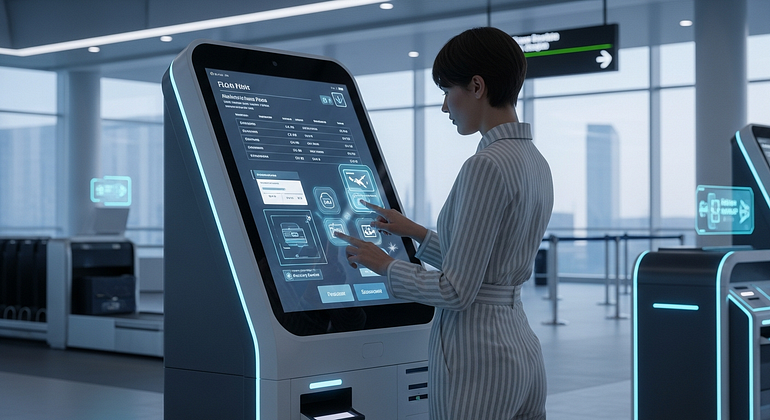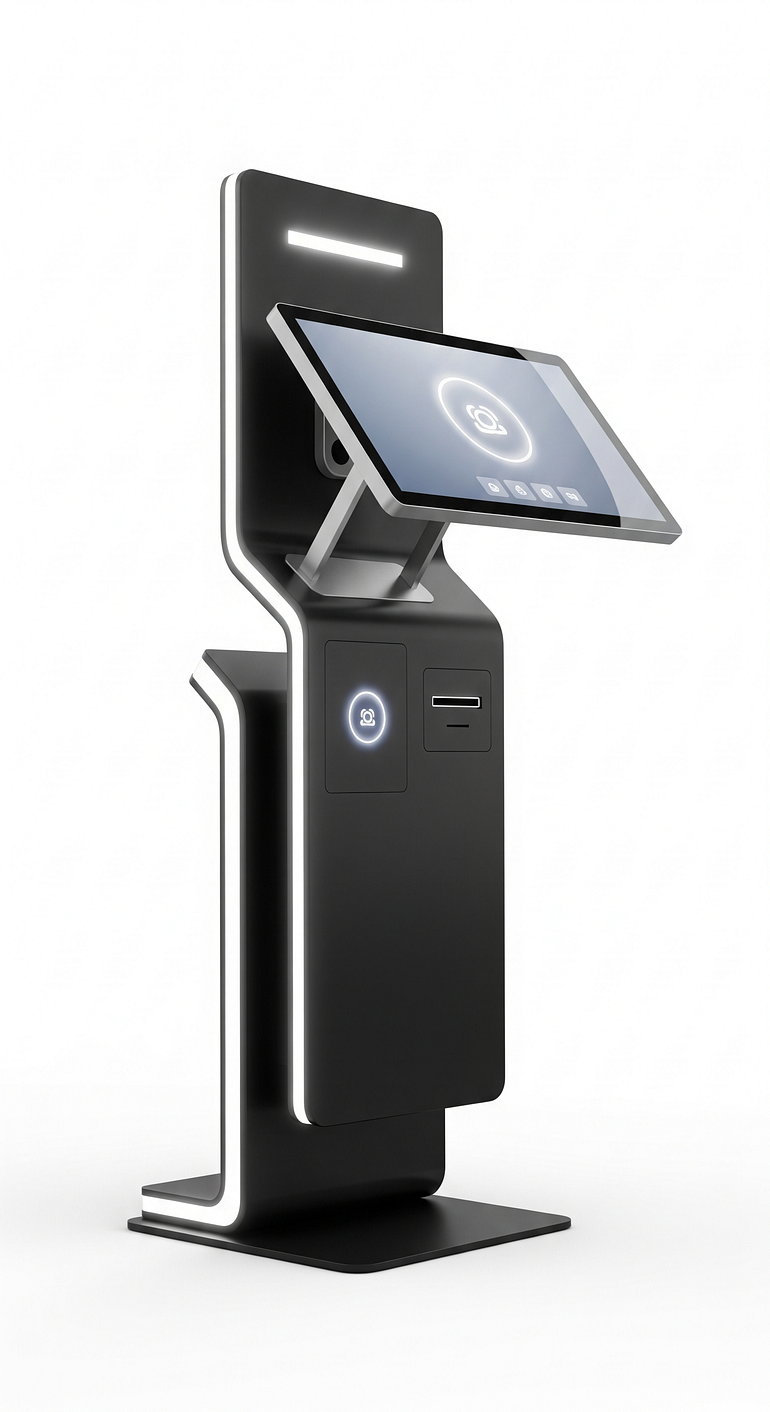
If you’ve ever stood in a long airport line, you know how stressful check-in can be — especially when flights are close and counters move slowly. That’s where airport kiosk solutions come in. These are easy-to-use self-service check-in systems that let travelers handle simple steps themselves — like checking in, choosing seats, and printing bag tags — without waiting for an agent. Picture sleek touchscreens placed across terminals, helping passengers breeze through routine tasks in minutes.
In this guide, we’ll explore how kiosks dramatically cut wait times, the technology that makes them fast, and the best practices airports use to roll them out successfully. You’ll also learn how biometric check-in is shaping the next wave of faster check-ins for travelers worldwide.
How Self-Service Kiosks Cut Wait Times at Check-In
Airports everywhere face the same challenge: too many passengers, too few counters, and not enough time. Self-service check-in kiosks solve that by shifting quick steps away from the counter and into the hands of travelers. The result? Shorter lines, smoother flow, and happier passengers at both large hubs and smaller airports.
The Step-by-Step Kiosk Flow That Saves Minutes
Here’s how a typical self-service check-in flow works:
- The traveler scans their ID, passport, or booking reference.
- The system finds their flight and confirms traveler details.
- They pick or change seats.
- They pay for extras, like bags or meals, if needed.
- They print their boarding pass and bag tags instantly.
This entire process often takes under 90 seconds, compared to several minutes at a staffed counter. Because multiple kiosks operate at once, dozens of passengers can check in simultaneously, reducing bottlenecks and freeing up staff to handle complex requests.
Early bag tag printing means travelers can head straight to bag drop, skipping another queue entirely. In busy hubs, this shift saves thousands of passenger minutes daily.
Keywords: self service check in, bag tag printing, faster check ins
Shorter Lines with Smart Queue Design and Wayfinding
The best airport kiosk solutions don’t just add machines — they redesign the flow. Kiosks placed before staffed counters naturally spread travelers out, keeping lines short and organized. Clear floor decals, overhead screens, and bright signage guide travelers to open kiosks and next steps.
Some airports design dedicated “kiosk zones” with arrows pointing to fast bag drop lanes, making the process smooth and intuitive. Many kiosks also allow groups or families to check in together, avoiding repeat lines.
The combination of clear directions, good placement, and self-service check in turns what used to be a 20-minute wait into a quick, easy process — even during peak travel hours.
Faster for More People: Accessibility, Languages, and Biometrics
Speed improves when everyone can use kiosks comfortably. That’s why modern systems are built for inclusivity. They feature large text, high-contrast displays, adjustable heights, and wheelchair-friendly spaces. Audio guidance helps visually impaired travelers, while multi-language support ensures no one feels lost.
Airports are also introducing biometric check-in, where travelers simply scan their face or fingerprint to confirm identity — saving time spent typing or searching for documents. When allowed, digital ID integration makes the process even smoother.
Accessible design plus smart tech equals faster check-ins for every traveler, no matter their age, language, or ability.
Keywords: biometric check in, airport kiosk solutions, self service check in
The Technology Inside Airport Kiosk Solutions That Makes Them Fast
The secret to a seamless check-in experience lies in the combination of reliable hardware, intelligent software, and secure design. Each component of modern airport kiosk solutions is built to eliminate friction and speed up every interaction.

Reliable Hardware for Speed: Scanners, Printers, Touchscreens
Every second counts when thousands of travelers are checking in. That’s why kiosks use high-speed 2D scanners that instantly read passports, barcodes, and boarding passes — even from mobile screens.
Thermal printers produce crisp bag tags and boarding passes that resist smudging and don’t jam — critical for maintaining flow during rush hours. Bright touchscreens that respond to gloved hands and payment terminals that support chip and tap make transactions effortless.
Designed for 24/7 operation, these kiosks include quick-swap modules for easy maintenance. Rugged builds reduce downtime, meaning more kiosks stay online, and travelers spend less time waiting.
Each hardware choice adds up to one result: faster, smoother, and more reliable check-ins.
Software That Connects to Airline Systems and Mobile Apps
Behind the screen, powerful airport kiosk software links directly to airline reservation and check-in systems in real time. That connection ensures every seat, bag, and boarding pass update syncs instantly across devices.
With mobile handoff, travelers can start check-in on their app and finish at the kiosk in seconds — often just to print bag tags. Features like auto-fill, saved traveler profiles, and offline queueing keep the experience seamless, even during network hiccups.
The result? Fewer retries, quicker confirmation screens, and less frustration — all contributing to faster check-ins and happier passengers.
Secure by Design: Privacy, Payments, and Data Protection
While speed is key, airport kiosk solutions also protect every interaction. Encrypted data channels, masked payment details, and automatic logouts keep information safe. Touchscreens lock after inactivity, and no data stays stored locally once a session ends.
Kiosks support contactless and chip card payments, minimizing handling and reducing errors. By prioritizing security and privacy, airports build traveler trust — which, in turn, means fewer rechecks, smoother throughput, and faster queues overall.
Trust, after all, is part of what makes self-service check-in work.
Best Practices to Deploy Kiosks for Faster Check-Ins
Having great tech isn’t enough; success comes from smart deployment and design. The following best practices show how airports can get the most out of their airport kiosk solutions — delivering speed, simplicity, and satisfaction.
Place Kiosks Where Travelers Need Them Most
Location drives convenience. Kiosks should be clustered near terminal entrances, parking shuttles, and train exits so travelers can check in early. Clear paths to bag drop counters prevent confusion and congestion.
Plan for reliable power and network access to avoid long cable runs or signal issues. Bright lighting and tall signs help kiosks stand out in crowded terminals, ensuring even first-time visitors can find them quickly.
Strategic placement sets the tone for faster check-ins from the very first step.
Design a Simple Kiosk UX That Anyone Can Use in Under 60 Seconds
A great user experience is what makes self-service stick. The best kiosks guide travelers through no more than 5 to 7 steps — each one clear, short, and visual.
Use plain language, large buttons, and progress bars to show where users are in the process. Friendly microcopy (like “Almost done!”) reassures travelers. Errors should appear in simple words with one clear fix.
Defaults — such as auto seat selection or saved traveler details — cut down on taps. Always support multiple languages and large-text mode for accessibility. Testing with real passengers before launch ensures everything works in real-world conditions.
When designed right, most travelers can complete self-service check-in in under a minute.
Add People Where It Counts: Roving Agents and Bag Drop Support
Self-service doesn’t mean no service. Smart airports keep floor staff nearby to help with exceptions, such as special items, name changes, or missing documents.
Roving agents assist families, elderly travelers, and first-time users, keeping lines moving. Meanwhile, staffed bag drops ensure bags move smoothly once bag tags are printed at kiosks.
Combining automation with a human touch creates confidence — and keeps even peak-hour operations calm and efficient.
Track the Right Metrics and Keep Improving
Continuous improvement keeps airport kiosk solutions effective. Start with key metrics:
- Average check-in time per traveler
- First-time success rate (no staff help needed)
- Reprint rate for boarding passes or tags
- Queue length by hour
- Traveler satisfaction scores
Airports that track these weekly can spot bottlenecks early and test fixes fast — like changing button wording or layout for better clarity. Regular reviews ensure the system stays optimized for faster check-ins and smoother flow.
Conclusion
Shorter lines and smoother trips aren’t luck — they’re the result of smart self-service, reliable technology, and thoughtful planning. When airports combine well-designed airport kiosk solutions with great placement, accessible UX, and trained staff, travelers experience faster, calmer journeys from check-in to boarding.
For airports looking to improve efficiency, the next step is simple: pilot kiosks in one area, measure the time saved, and scale up from there.
With biometric check-in and digital ID verification growing rapidly, the future of air travel promises even quicker, more seamless experiences — turning every trip into a smoother start to the journey.
FAQs on Airport Kiosk Solutions
1. What is an airport kiosk solution?
An airport kiosk solution is a self-service check-in system that allows travelers to check in, select seats, and print bag tags without waiting at counters.
2. How do self-service kiosks make check-ins faster?
They reduce dependency on staff by letting multiple travelers check in simultaneously. Most complete the process in under 90 seconds, leading to faster check-ins overall.
3. Can I check in luggage at a kiosk?
Yes. Most kiosks allow you to print bag tags, which you can then attach to your luggage before heading to a fast bag drop counter.
4. Are airport kiosks safe to use for payments and personal data?
Absolutely. Kiosks use encrypted connections, masked card details, and automatic logouts to ensure security and privacy.
5. What is biometric check-in?
Biometric check-in uses facial or fingerprint recognition to confirm your identity quickly, removing the need for manual data entry or physical documents.
6. Do kiosks support multiple languages?
Yes. Modern airport kiosk solutions support several languages and accessibility features like large text, contrast modes, and voice guidance.
7. Can small airports benefit from kiosks too?
Definitely. Even smaller airports use self-service check-in kiosks to manage peak times and improve passenger flow without adding more staff.
Comments
Post a Comment